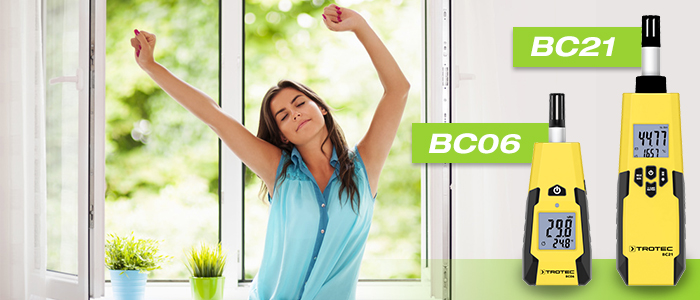Customers and readers are asking us more and more questions on the topic of ‘ventilation’ in houses and flats. Many people rightly fear that too much moist air remains in their rooms due to incorrect ventilation – and the mould fungus thereby finds a place to settle. This can cause your health to suffer: Mould fungi form cancer-inducing toxins and can trigger allergies. So here are 11 tips for ventilating properly – for zero tolerance to mould!
Tip 1 Ventilate bedrooms particularly intensively
Ideally, you should sleep with the window open or tilted at night, since this involves the biggest air exchange. If it is too cold for you, particularly in winter, you should perform an intensive intermittent ventilation with the window wide open.
Tip 2 Ventilate living rooms regularly
You should also ventilate regularly in the living room to remove moisture. Particularly if there are plants or other sources of moisture, for example laundry or indoor fountains. An intermittent ventilation should be carried out at the latest when you see water drops on the window panes.
Tip 3 Note special rules in the kitchen and bathroom
A large amount of moisture accumulates in a short time in these rooms due to their intended purpose. It is best to remove the “moisture peaks” after showering, bathing and cooking immediately afterwards through intensive window ventilation. When doing this, you should close the bathroom or kitchen door, otherwise the moisture and odours can spread to the whole flat. And when in the bathroom after showering, think about wiping the water from the walls and floor.
Tip 4 Ventilate the basement on summer nights
Do not ventilate the basement during the day in the summer months, but at night or during the early hours of the morning. In winter, you can ventilate it at any time of day. Why is this so? Because the external walls of basements are also relatively cold in summer. As a result, air moisture settles on the cold basement wall and condenses when warm air enters the basement – ideal conditions for mould fungus.
Tip 5 Perform intermittent ventilation correctly
Correct intermittent ventilation works best when interior doors are open. In this way, you increase air exchange. If possible, open the windows on the opposite façade, too, so as to generate a particularly effective draught ventilation. It is better to keep doors leading to lesser heated rooms closed.
Tip 6 Do not keep windows permanently tilted
During the day, you should close the windows in the bedroom that have been placed in the tilt position overnight. It is best to turn down the heating at night in order to keep energy consumption under control.
Tip 7 Remove building moisture with intensive ventilation
Building moisture enters the building both during new construction and after renovations, for example through plaster and screed work. This moisture must be eliminated from the building by ventilating all rooms intensively – this normally takes 1 to 2 years in new buildings. Unfortunately, you have to allow for higher heating costs during this period.
Tip 8 Check the ventilation behaviour after renovation
Renovation may lead to a new critical moisture situation in the flat. For example, when the windows are renewed, but the external wall is still not thermally insulated. In this instance, the ventilation behaviour must be adapted and ventilation should be carried out more often or for a longer period. Landlords should proactively inform their tenants about the consequences of renovation measures for ventilation behaviour.
It is also recommended that you control the relative room air humidity in the flat with a climate measuring device, the so-called thermohygrometer – such as the BC06 or the BC21 from Trotec.
Tip 9 Drying laundry in the flat
If possible, laundry should not be dried inside the flat. If this is unavoidable, for example because there are no drying areas or drying rooms, intensive ventilation must be carried out: For this period, position a window on tilt, keep the room door closed and do not turn off the heating.
Tip 10 Ventilate with the ventilation system
If you have a ventilator-supported ventilation system, you can almost completely do without window ventilation. Intensive ventilations are then only required during “moisture peaks”. If only certain rooms have ventilation systems, for example a decentralised ventilation unit or an extractor fan in the bathroom, you should ventilate the rest of the flat using the windows as normal.
Tip 11 Regular air humidity checks
In order to protect yourself and your loved ones from dangerous mould formation, it is necessary to regularly check the air humidity – use our thermohygrometers BC06 or BC21 for this. See for yourself how perfectly these climate measuring devices determine the exact temperature and relative air humidity values in the blink of an eye – available now in the Trotec shop!


